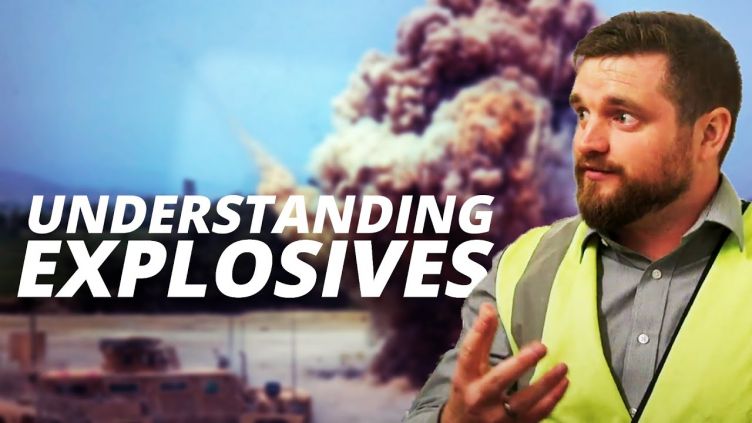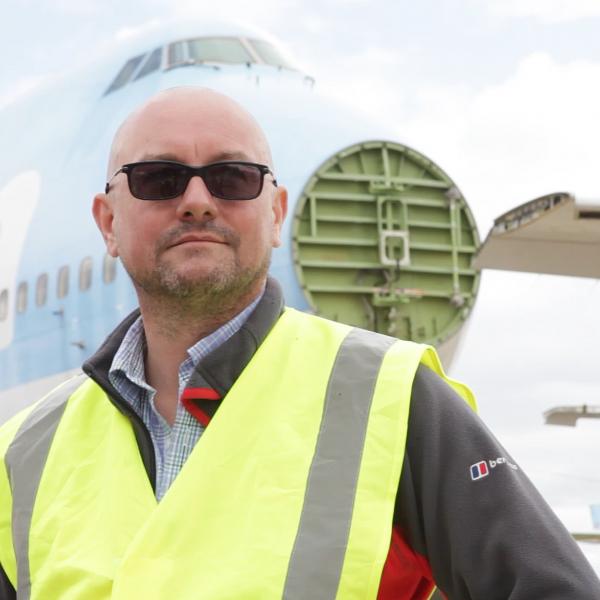What happens when a bomb explodes?
Improvised explosive devices are used around the world with huge consequences. What happens when a bomb explodes and how can this information save lives?

For much of the 20th century, the major explosive threats were from very large conventional or nuclear weapons. Over recent decades, however, smaller improvised explosive devices or IEDs have been used throughout the world with devastating consequences. Whereas very large explosions can produce devastating effects at long distances, IEDs typically do damage over much shorter ranges. The problem is that they’re really hard to defend against because we don’t really know how explosions work at such close distances. But at the University of Sheffield we're working with the Ministry of Defence to conduct truly life-saving research in this area.
- Transcript
-
- In 1945, when the United States dropped atomic bombs onto the Japanese cities of Hiroshima and Nagasaki, each instantly levelled several square miles. This new atomic age was expected to change the face of warfare. But since then, battlefield explosives have moved in a different direction. They've become smaller and much more targeted. Today Improvised Explosive Devices, or IEDs, are used throughout the world with devastating consequences. One of the big reasons IEDs are so hard to defend against is that we don't actually really understand how explosions interact with targets at very close distances. But if we can decipher what's going on, we have the potential to save lives, all over the world. I've come to the University of Sheffield unique blast laboratory to meet civil engineering researchers Sam Clarke and Sam Rigby, who are attempting to solve this problem.
- So there's a lot of really good work done in the 1940s,1950s on nuclear explosions and being far away from big bombs, we developed a very good understanding from that. But things have changed. Now the threat is IEDs, small explosives, very, very close in, and that's where the scientific challenge is. So within the first microseconds after detonation, that's what the Ministry of Defence are really interested in as well because if we understand that better, we can help save lives.
- At the time when we started working with the university, nobody really understood the pressure that was being exerted on the underside of a military vehicle when an explosion detonated underneath it.
- This is Ian Elgy. He works in the Defence, Science and Tech Lab for the Ministry of Defence, where he leads a team working to protect people in military vehicles from mines and IEDs.
- Although there were simulations which could help us in predicting how that military vehicle will respond. They're essentially limited in their use because we couldn't guarantee their reliability. So what Sam and Sam were able to do is start collecting data to look at what was very, very important when we do those explosive tests and then they could start developing test methods that allowed us to explore this in a lot more detail.
- To highlight what's important to understanding how IEDs affect vehicles and why we don't have reliable computer models the Sams have set up two explosive tests for me to film with a high speed camera.
- So this is a hemisphere of high explosive and it's on top of a steel anvil, which we're basically using to protect the ground.
- So that doesn't look like very much explosive.
- Well, technically, there's about the same energy in there as a mars bar. But the critical thing with the high explosive is it's how quickly it gives out the energy and it's how that energy then dissipates into the environment that we're really interested in.
- Why is this better than just modelling it on a computer?
- So some of the physics, when we're far away, like we said before, the computers fine at doing that, but very close in the physics kind of breakdown. We don't quite kind of exactly know what's going on. And so that's what we have to resort to actually experimentally defining this thing again. You have to have experimental data to validate your models. What we're here to do is to actually get that experimental data in the region that's so hard to measure and that's why it's so important.
- So in this first test, we're going to let the blast wave from the explosive spread into the area around it so that we can see what a typical shockwave looks like.
- OK, Sam, is a camera armed?
- Yep, just coming out.
- OK, firing point to sentry report. All clear, please. OK, copy that.
- Is everyone ready? Three, two, one.
- Excellent, well done.
- So this is the high speed video footage from the test that we've just done. If you look out over here on this side of the screen, you'll actually be able to see the shockwave from the explosion - sort of look around here. Do you see that ripple?
- That here?
- Looks like water is kind of running over the lens. We have the big flash and then we've got this fireball that's expanded to this sort of radius. And inside here the shopfront itself is still inside the fireball.
- So now if you look around here, do you see that disturbance that's sort of moving outwards? We're quite comfortable with this sort of region once the shockwave detaches from the fireball, what we're going to do in the next test is we're going to put a structure round about here, so, quite close to the explosive. And then we're going to see some interesting interactions happen. We're going to see the fireball and the shockwave all interacting with the structure and kind of feeding one another. And that sets the challenge for the work that we're doing here at the laboratory.
- All right, so let's see if we can find this out, scrolling through. So you can immediately see how different this is. You can already see that you get these strange interactions here on the right.
- Yes. It's not the same just like a normal shockwave.
- That's exactly right yeah. So you get these reflections coming back through the detonation products afterwards. So it's the interactions that go along in this section here when it hits the target that are of real interest to us.
- Now, unlike with the first test, you might be struggling to see whether reflections of the blast wave interacts with the fireball. But that's exactly the point. This is really hard to see and more importantly, it's really hard to measure. But this is precisely what Sam and Sam have been able to do by building a unique testing picture called the characterisation of blast loading or CoBL for short. It consists of a large metal disk loaded with pressure bars that act as dynamic force transducers. Basically, this means that the bars can measure extremely high magnitudes of pressures over a really short period of time, the exact types of pressures you get when a small explosive device detonate at a really close range.
- What this was able to do is able to resolve what the pressure was in a really, really small area of that plate and then how that differed from the pressure, a few millimetres further away and a few millimetres further away from that and a few millimetres further away from that. So that gave you far more information about what was going on on that kind of critical interaction surface, which would then lead you to be able to predict what was going to happen to a vehicle or armour system that you then have there, how that would deform and then how that would ultimately lead to causing injuries or ideally preventing injuries in the people sat inside that vehicle.
- This is the sort of information that we get. So this is using a much, much faster camera than the one that we've done for the two demonstration tests that we showed today. This is filming about 160000 frames per second. So this is the fireball similarly and then we can see the shockwave and the fireball hitting the target right at the top and this is where we measure. So the big challenge that we've faced is the fact that in this region, we've got this combined loading, we've got the shockwave and we've got the fireball that's hitting the target at the same time. We've got this interaction between the two and this is something that drives that strange physics that I mentioned earlier, the fact that we've got two fluids, one's on top of the other and they don't really want to be there. They want to swap positions, swap places. Part of what we've learnt from our experiments is that you need to understand what's going in the fireball in order to understand the loading that's developed on the target because that chemical composition feeds into what the loading becomes.
- So how then can you take that information and apply it to the real world? Is that possible now?
-Yeah, I think that's where numerical models have to come in. And what we end up doing is providing the crucial validation data for people like the guys at MoD, DSTL, where they are looking at modelling these kind of situations and we're able to provide them for the first time with these very close and detailed experimental results that allows them to validate their models.
- The fundamental understanding of why something is as it is gives you so much more scope to make use of the information. That system that they've developed is fantastic because it allows us to do something that nobody has ever done before. There's nobody else in the world who is able to look at the point on a on a flat plate and say the pressure being exerted there is 250 megapascals and that pressure wave is lasting for three milliseconds. So being able to have that information makes the rest of the process of designing protected military vehicles much, much easier. And thanks to the work that the university has been doing, we are better able to do that. And there are more people coming home with fewer injuries than they would have been otherwise.
The science behind explosions
We show YouTuber Tom Scott our work to uncover what happens in the first moments after detonation so that building explosive-resistant structures is easier and cheaper - which could help save lives.
Related research
Characterisation of buried blast loading
Measuring spatial pressure distribution from explosives buried in dry Leighton Buzzard sand
Predicting the role of geotechnical parameters on the output from shallow buried explosives






